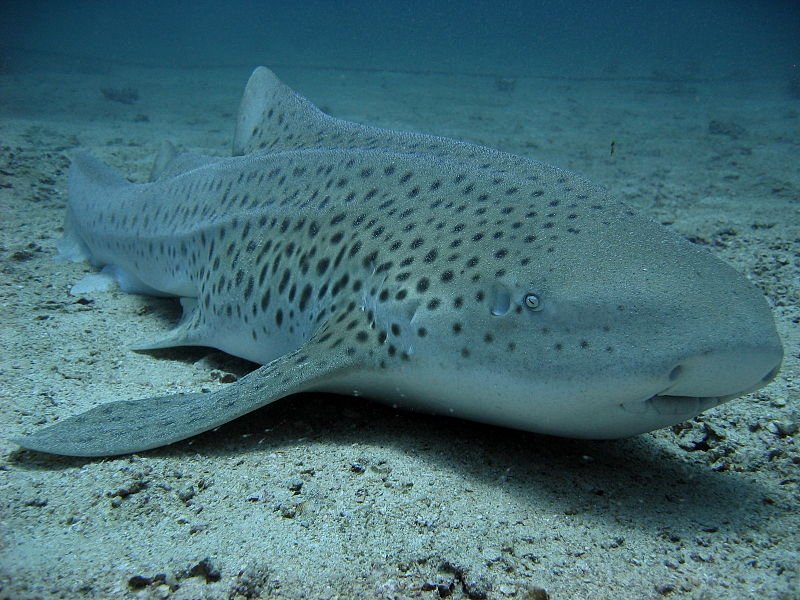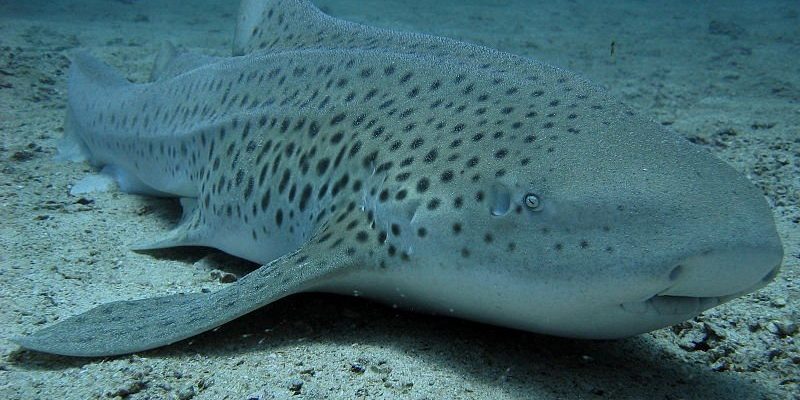
Zebra sharks, known scientifically as *Stegostoma fasciatum*, are often found in warm, shallow waters around coral reefs. Unlike many of their shark cousins, they are not the vicious predators you might imagine. Instead, they’re more like the friendly giants of the ocean! In this article, we’ll explore ten interesting facts about zebra sharks, from their unusual feeding habits to their stunning transformations as they grow. So, grab a cup of coffee and let’s get started!
1. Unique Appearance with Striking Patterns
One of the first things you’ll notice about zebra sharks is their unique appearance. As juveniles, they have bold black and white stripes that resemble a zebra, which is how they get their name. As they mature, these stripes gradually fade into a pattern of spots and blotches. This transformation is quite stunning and gives them a remarkable look throughout their lives.
These patterns are not just for show; they also serve a purpose. The stripes help juvenile zebra sharks blend into the sandy ocean floor, providing camouflage from predators. It’s like nature’s own version of a stealth suit! This ability to blend in is crucial for survival when they’re younger.
As they grow, zebra sharks can reach lengths of up to 11 feet, making them one of the larger shark species. It’s fascinating to think how their appearance evolves, much like how we grow and change over the years.
2. Gentle Giants: Not Your Typical Shark
You might be surprised to learn that zebra sharks are often described as gentle giants. Unlike many other sharks that are known for their hunting prowess, zebra sharks are mainly bottom feeders. They prefer to munch on tasty marine delights like crustaceans, mollusks, and small fish. Imagine them like the peaceful diners of the ocean, slowly cruising along and enjoying their meals without causing a fuss!
These mellow sharks tend to be more curious than aggressive, often swimming up to divers to check them out. It’s a bit like having a friendly dog approach to greet you. Instead of fearing for your life, you can actually admire their beauty up close!
In fact, they’re so docile that they are often kept in aquariums, where people can appreciate their uniqueness without worrying about being in danger. Watching a zebra shark swim gracefully through the water is truly a mesmerizing experience.
3. Habitat Preferences: Coral Reefs and Beyond
Zebra sharks are typically found in warm, shallow waters of the Indo-Pacific region, including places like the Great Barrier Reef and around the coasts of Indonesia and Madagascar. They prefer environments with coral reefs, sandy bottoms, and seagrasses, where they can easily find food and hide from predators.
You might be wondering why they prefer these specific habitats. Well, coral reefs offer a rich source of food and plenty of nooks and crannies for zebra sharks to hide and rest. They often hunt during the night, using the cover of darkness to find their next meal. It’s like having the best restaurant in town right in their backyard!
As a result of their habitat preferences, zebra sharks are considered quite adaptable. They thrive in various shallow coastal environments, which helps ensure their survival despite changes in their surroundings.
4. Breeding Behavior: A Slow Reproduction Cycle
When it comes to breeding, zebra sharks have a rather slow reproductive cycle. They are oviparous, meaning they lay eggs, which is quite unusual among sharks. Female zebra sharks can lay up to four eggs at a time, usually in a sheltered area like a crevice or an area with plenty of vegetation. The eggs are contained within a tough, leathery casing, almost like a protective pouch.
It can take about six months for the eggs to hatch, and when they do, the baby zebra sharks are around 10 inches long. That’s a decent start for the little ones! They are fully capable of fending for themselves once they hatch, and the mother does not stick around to care for them. It’s a bit like tossing your kid out into the world to see how they do—nature’s way of ensuring they learn quickly!
Their slow reproduction rate makes the survival of this species critical, especially considering their natural habitats are threatened by human activities like fishing and pollution.
5. Conservation Status: Protecting the Zebra Shark
Despite their fascinating traits, zebra sharks face challenges in the wild. They are currently listed as Near Threatened by the International Union for Conservation of Nature (IUCN). Their populations have been declining due to overfishing, habitat destruction, and the aquarium trade.
Efforts are in place to protect these remarkable creatures, including marine protected areas and regulations on fishing. Many aquariums also participate in breeding programs to help maintain healthy populations. It’s like a safety net for the zebra sharks—ensuring their future survival.
You can play your part, too. Supporting sustainable seafood practices and advocating for ocean conservation can make a difference. If we all take small steps, we can help ensure that future generations experience the wonder of zebra sharks.
6. Social Behavior: They Value Their Space
Zebra sharks are generally solitary creatures, preferring to roam around their territories without much fuss. However, they don’t mind being around other zebra sharks, especially during mating season. It’s fascinating to think of them as both independent and social at different times!
When they do come together, it’s often for short periods. After all, they aren’t the type to throw big social gatherings. Their interactions tend to be peaceful, filled with curious glances rather than aggressive confrontations. It’s almost like watching a group of acquaintances who acknowledge each other but still enjoy their own personal space.
This interesting social dynamic contributes to their calm demeanor, making them less prone to stress compared to more aggressive shark species. Here’s a little trivia: if you’ve ever seen a zebra shark resting on the ocean floor, it’s probably just taking a breather, enjoying a quiet moment in its underwater world.
7. Adaptations: How They Thrive
Zebra sharks come equipped with several unique adaptations that help them thrive in their environments. For one, they have a flexible body and wide pectoral fins, allowing them to glide smoothly through the water. This form permits them to maneuver easily within coral reefs and rocky seafloors without getting stuck or harmed.
Their electroreceptive abilities are another fascinating adaptation. Zebra sharks can sense electric fields generated by the movements of prey—similar to a sixth sense! This helps them locate food even when it’s hidden in the sand or amongst rocks. Imagine having a superpower that allows you to know exactly where lunch is hiding!
Additionally, their camouflage is a brilliant adaptation for both hunting and evasion. The spots and colors of their skin help them blend into their surroundings, making it hard for both prey and predators to spot them. It’s like wearing a natural disguise that keeps them safe in the big blue ocean.
8. Zebra Sharks in Aquariums: A Popular Exhibit
Many aquariums around the world feature zebra sharks due to their intriguing nature and relatively calm demeanor. They’re not just eye candy; they also play an essential role in educating the public about marine ecosystems. Visitors often find themselves captivated by these creatures as they swim gracefully past the glass.
In captivity, zebra sharks can live long lives, often reaching up to 25 years or more, depending on the care they receive. Well-maintained aquariums mimic their natural habitats, which helps keep them healthy and happy. Their presence encourages conversations about marine conservation, inspiring visitors to think about the ocean’s health.
Moreover, some aquariums run breeding programs to help maintain zebra shark populations, contributing to conservation efforts and ensuring the species thrives for years to come. It’s rewarding to think about how these gentle sharks are making an impact, even within the confines of an aquarium.
9. The Role of Zebra Sharks in the Ecosystem
Zebra sharks play a key role in their marine ecosystems. As bottom feeders, they help maintain the balance of marine life by controlling the populations of various prey species. By consuming crustaceans and other small animals, they keep these populations in check, which can prevent overgrazing of seagrass and other critical habitats.
Moreover, they contribute to the overall health of coral reefs. Healthy reefs support a wide variety of marine life, and zebra sharks are part of that intricate web. When you think about it, every shark, no matter how gentle, has a purpose. It’s like being a piece of a giant puzzle; without them, the picture of the marine ecosystem would be incomplete.
This interconnectedness emphasizes the importance of preserving their habitats. Protecting zebra sharks is not just about saving one species; it’s about ensuring the health of entire marine environments.
10. Fun Facts and Myths about Zebra Sharks
Let’s wrap up with a few fun and quirky facts about zebra sharks! Did you know that they’re sometimes called “carpet sharks?” This nickname comes from their flat bodies and textured skin, which resembles a carpet. It’s kind of adorable when you think about it!
Another interesting tidbit: they can rest by lying on the ocean floor, propped up on their fins, instead of swimming continuously. It’s a bit like a cat curling up for a nap, and it showcases their relaxing lifestyle.
As for myths, some people mistakenly believe that all sharks are fierce predators, but zebra sharks challenge that stereotype. They are truly gentle creatures that rely more on stealth than aggression.
In conclusion, zebra sharks are captivating creatures that remind us of the ocean’s wonders. Not only are they beautiful and intriguing, but they also contribute significantly to marine ecosystems. By learning about them, we can all play a part in their conservation and ensure they continue to thrive for generations to come. So next time you think about sharks, remember the zebra shark, the gentle giant of the sea!

